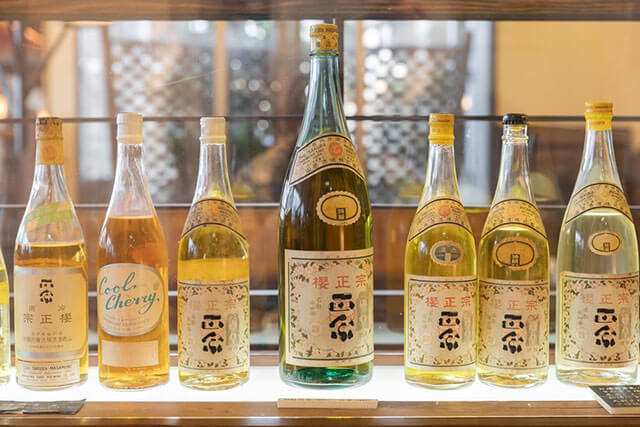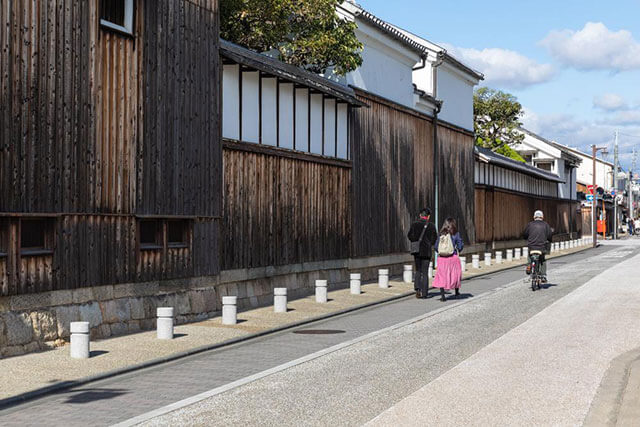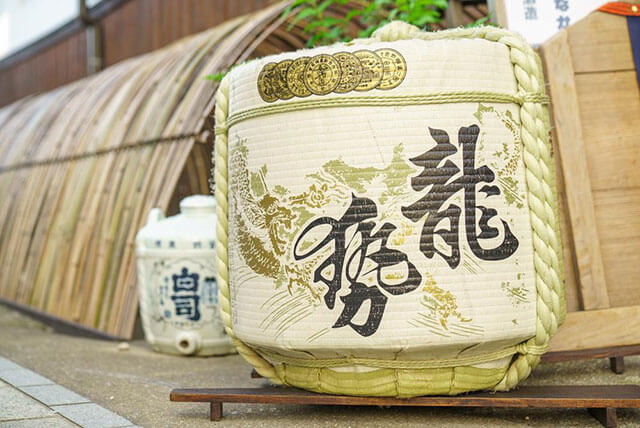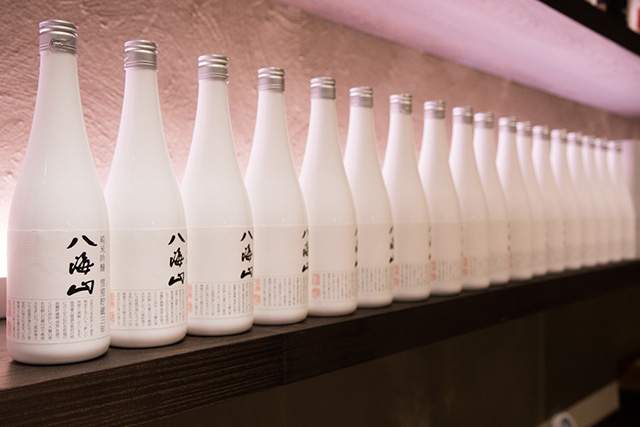
Having over 2000 years of history, Japanese Sake, otherwise known as “Nihonshu”, is an alcoholic beverage made with fermented rice, popular worldwide. Sake brands like Otokoyama, Hakkaisan and Born have been renowned for their tastes globally but there are many others that Japan has to offer. To have a better understanding of what Nihonshu is, take a look at the guide below.
-
01
Origin of Japanese Sake
There is a theory that sake originated in western Japan, in the Kyushu and Kinki regions. It is thought that the oldest description of sake made from rice is found in the "Osumi Province Fudoki"( ancient reports on Osumi province’s culture, geography, and oral tradition). According to this report, heated rice is chewed in the mouth, saccharified by enzymes contained in saliva, and fermented by wild yeast to make sake. Only shrine maidens were allowed to perform this process and these sake were made for the gods.
Another theory is from a mythical point of view where the first sake made in Japan is a sake ordered to be made by Susanoo-no-Mikoto to defeat the Yamata-no-Orochi. The "Yashioori-no-sake" mentioned in this myth appears in the Kojiki (Records of Ancient Matters) and the Nihon Shoki (Chronicles of Japan), and is an ancient reminder of the origins of sake brewing.
However, it is said that the raw material for Yashioori-no-Sake may not have been rice, but nuts and fruits. Whether brewing techniques existed before the use of rice or where it originated remains a mystery. -
02
How to make Japanese Sake
![]()
According to the Liquor Tax Law, sake is defined as "a product made by fermenting rice, rice malt, and water".
Step 1
First, rice must be polished. The outside of brown rice contains a large amount of protein, fat, and inorganic substances. If there are more of these than necessary, the taste, aroma, and color of sake will be adversely affected, and the quality of the sake will deteriorate. Therefore, during sake brewing, 25-50% of the outer surface of the brown rice is removed and the polished white rice is used.The polishing process takes more than six hours and involves carefully adjusting the speed and resistance of the rigid rolls in the rice polishing machine to ensure that no germ or groove remains, and that the rice looks as close to its original form as possible. Some sake like Daiginjo that has a polishing ratio of more than 50% can take between 2 to 3 days to polish.
Step 2
These polished white rice are then steamed. During this steaming process, it breaks down the starchy tissue in the rice grains, making it easier for the koji mold to multiply and for the enzymes to dissolve. At the same time, it also serves to sterilize the white rice. After steaming, rice is then cooled to a temperature appropriate for the purpose for which it is to be used: for koji, for moromi (sake mash), and for rice to be used directly in the mash. In the old days, rice was spread out on a mat and cooled naturally by the outside air, but nowadays, conveyor belt type rice coolers are widely used.
Step 3
Once the rice is ready, then comes the koji making. To make it, the koji spores are sprinkled over steamed rice that has been cooled to about 30 degrees Celsius. This koji has a great impact on the quality of the sake, so it must be made pure white, fragrant, dry and fluffy, and of good quality to meet the purpose of use. While koji is used as a source of various enzymes, amylase, a starch-degrading enzyme that breaks down rice starch and converts it into glucose is especially important. This glucose is then used by sake yeast for alcoholic fermentation.
Step 4
After the koji is ready, shubo is then being prepared. Shubo is an excellent yeast made of steamed rice, koji, yeast, water and lactic acid, all cultivated for brewing sake. It plays a decisive role in breaking down sugar to produce alcohol, which is then used to make sake.
Step 5
Now that koji and shubo are made, the final ingredient, moromi (sake mash) can be made. Moromi is a liquid that is being fermented. It is made by adding shubo, koji, steamed rice, and brewing water, and is the preliminary stage of sake production.
Step 6
Once this moromi is completely fermented, it is then pressed to separate the sake lees. Sake is called "seishu(清酒)" under the Liquor Tax Law, but it cannot be called "seishu" until moromi is filtered.
Step 7
Once all process is done, before bottling it to be out in the market, sake is pasteurized, and placed in cold storage where it matures. Depending on the sake types, this pasteurization process is omitted. (See the section “What is Pasteurization”)![]()
-
03
4 Categories of Japanese Sake
There are thousands of different brands of sake and even with the same quality of sake, the taste and aroma can vary from brewery to brewery. But all of them are said to fall into one of the following four categories.
Fruity Type (薫酒)
Mainly Daiginjo and Ginjo type, this type of sake has a reminiscent of sweet fruits and flowers. The sweetness and thickness are moderate and well balanced with the acidity that brings a refreshing taste. On the other hand, bitterness and umami are low, making the taste bright and refreshing. The gorgeous aroma is high in the mouth, but the aftertaste is short. There are many different types, ranging from those with a sweet flavor to those that are dry.
Light Type(爽酒)
Mainly Honjozo, this type of sake has the lightest flavor of any sake, and is characterized by its refreshing drinkability. It is light and dry with a hint of sweetness, fresh acidity, and a small amount of pleasant bitterness that adds to the freshness of the sake. Reminiscent of grains and a sense of maturity can hardly be seen.
Full Body Type(醇酒)
Mainly Junmai sake, this type of sake can feel the flavor and richness of the rice and is very robust and can stand up to strongly seasoned dishes. It is characterized by a rich aroma reminiscent of the rice itself. The sweetness and acidity are harmonized with a pleasant bitterness and a full flavor.
Mature Type(熟酒)
A type of sake with a refined aroma and mellow flavor. Some junmai-shu also fall into this category. It is dark in color, has a nutty aroma, a heavy, moderately bitter taste, but with a good aftertaste. -
04
Specially Designated Names
Japanese sake has a label on each bottle to let the customers know which variations (ex. Junmai, Daiginjo etc. ) the sake falls under. This is called "Tokutei Meisho," literally translated as Special Designated Names. These sake are classified according to the ingredients and rice polishing ratio.There are eight different types.
Honzojo-shu/Tokubetsu Honzojo-shu
Honjozo-shu (sake) is made from rice and rice malt with a polishing ratio of 70% or less, brewing alcohol and water, and must have a good flavor and color. The amount of brewer’s alcohol that can be added is limited to 10% of the weight of the rice used.
This type of sake is generally less aromatic and has a simpler taste than ginjo sake. If the rice polishing ratio is less than 60% or if a special brewing method is used, then the sake will be classified as "tokubetsu (special) honjozo sake".
Ginjo-shu
Ginjo-shu must be made from rice, rice malt, water, brewer's alcohol with a polishing ratio of 60% or less using the ginjo-zukuri method, and have a good inherent flavor and color.
Polishing ratio of 60% or less means that the rice has been polished at least 40%. The process of slowly fermenting the rice at low temperatures is called "Ginjo-zukuri".
While the polishing ratio of 60% or less is classified as Ginjo-shu, polishing 50% or less is classified as Daiginjo-shu.
See the section “Ginjo-Zukuri” for more details on the process
Junmai-shu
Junmai-shu is a sake that is made from rice, rice malt, and water. In other words, junmai-shu is a sake that has no alcohol added during the production process (sake made only from rice). It is characterized by a deep taste of rice and a rich aroma in the mouth. The junmai-shu group includes junmai-shu, junmai-ginjo-shu, junmai-daiginjo-shu, and tokubetsu-junmai-shu, each of which has different requirements in terms of rice polishing ratio and flavor.
Junmai Ginjo-shu/Junmai Daiginjo-shu
Junmai-shu made by the Ginjo-zukuri method is called Junmai Ginjo-shu or Junmai Daiginjo-shu. Ginjo-zukuri is a process in which more polished white rice is slowly fermented at low temperatures to produce a unique aroma called "ginjo-koh".
However, if the sake is to be called Junmai-Ginjo-shu or Junmai-Daiginjo-shu, there is a requirement on the rice polishing ratio.
Junmai Ginjo sake must be polished to 60% or less. Junmai Daiginjo sake must be polished to 50% or less. In other words, Junmai-Daiginjo sake is made by polishing more rice than other types of sake.
Tokubetsu Junmai-shu
Each sake brewery has its own standards, but in general, "tokubetsu junmai-shu" is made by polishing the rice even more than "junmai" in order to achieve a cleaner flavor with less miscellaneous tastes. The polishing ratio must be under 60% and be made with a special brewing process. However, there is no specific rule for this special brewing method, and it is up to the brewer to decide what kind of brewing method is considered "special". And the brewer must indicate on the label what makes the brew special, such as the ingredients and production method.![]()
-
05
Types of Sake
In addition to the Specially Designated Names (Tokutei Meisho), there are a variety of other types of sake based on their production characteristics.
Nama-zake(生酒)
Literally translated as “raw sake”, this type of sake has not been heat-treated. Although the quality of sake can easily change, it has a unique taste and freshness that can only be found in unpasteurized sake.
Namachozo-shu(生貯蔵酒)
According to Japanese law, Namachozo-shu can only be labeled as "sake that has been stored without heat treatment after production, but heat-treated when it leaves the production site.
Namachozo-shu is characterized by the same freshly squeezed flavor as Nama-shu, but heat treatment during the production process solves the problems of biochemical changes in composition and fire loss during distribution. The mainstream products are those that are served chilled.
Namazume-shu(生詰酒)
This type of sake has been stored after it has been heated, and the second heating process is omitted before shipping. Since the yeast has stopped fermenting before storage, the quality of the sake can be said to be relatively stable.
Genshu(原酒)
Sake on the market generally has water added, but genshu (undiluted sake) has no water added and has a higher alcohol content of 18 to 20. Because of its high ABV, Genshu may be a little difficult to drink, but its powerful and unique taste is addictive to some drinkers.
Orizake(おり酒)
Ori is a white sediment too fine for the filtration to leave after the moromi (sake mash) has been pressed. This Orizake is a type of sake that left its “ori” and bottled it making the sake look white. While it looks similar to nigorizake, the main difference is that the sediment for orizake is finer. It is rich and sweet with a smooth taste that spreads the flavor of the rice.
Nigori-shu(にごり酒)
Similar to Orizake, Nigori-shu is a cloudy white sake that has only been filtered through a coarse cloth. It is characterized by its rich and robust taste and because it contains a lot of lees, the original mellow aroma and flavor of the rice can be felt more deeply. There are two types, one is called kassei nigori-shu(活性にごり酒) because the yeast and enzymes are still alive and have not been heated or sterilized during shipment. It is fizzy and has a refreshing taste. The other is called the usu-nigori or sasa-nigori. Although there is no specific standard to this type, it is usually less cloudy and said to be easier to drink, more suitable for beginners.
Taruzake(たる酒)
Taruzake is sake that has been placed in a cask to impart the aroma of wood, and is served in the cask or in another container such as a bottle. The natural aroma of sake, combined with the aroma of the wood used in the cask, such as cedar and cypress, harmonized well to create a unique and refreshing aroma. It is also said that sake becomes mellower and more pleasant as it sits in the cask. -
06
Types of Sake by Storage Period
Depending on the terms of storage, sake is separated into two categories: the aged sake (koshu古酒) and new sake (shinshu新酒). Even with the same brand, there is a big difference in taste and flavor between these two.
New Sake (Shinshu新酒)
The brewery year for sake starts from July 1st and ends in June in the following year. Normally, sake brewing begins in October, when the rice is harvested, and is shipped in March of the following year. Sake that is brewed and shipped within this time is called “shinshu (new sake)”. It is also known as "Shiboritate”, literally translated as freshly brewed and is only available in winter and spring. Because of the short storage period, it has a fruity, refreshing aroma and a fresh taste.
Aged Sake (koshu古酒)
Koshu (aged sake) is a sake that began their production in October and shipped after June in the following year. The period of maturation varies depending on the brewery and the brand but can be applied to a sake anywhere from a year to more.
Generally speaking, aged sake has a brownish color, like amber and tastes like cocoa and caramel with a hint of sweetness. Because of its characteristic with a more distinctive color and flavor than new sake, it is recommended to drink it in a wine glass to get the most out of its characteristics. As sake is slowly aged over time, the enzymes work to eliminate miscellaneous flavors and stabilize the taste. Particularly in the case of junmai sake, since it is made only from rice, the aroma and flavor of the rice can be enjoyed more.![]()
-
07
Change in Taste Depending on the Pressing
Sake made by pressing the “moromi” (Sake mash) have different characteristics depending on when it is collected, and each has its own name. There are three types: Arabashiri, which comes out naturally from the mash, Nakadori (middle part), which comes out after a bit of pressure is applied, and Seme, which comes out at the end after more pressure is applied.
Arabashiri
Arabashiri is the first sake that comes out when sake mash is squeezed and it is very rare because only a small amount of it comes out naturally by the weight of the mash without pressure. It is also the liquor that flows out and starts to run while the sake bags are being stacked. The first sake to come out is thin and cloudy, and has a relatively low alcohol content. It has a wild, sharp and fresh taste, with a gorgeous aroma.
Sake is named according to the order in which it is squeezed and comes out. The first part that comes out is Arabashiri followed by Nakatori, then lastly, Seme. However, there is no precise definition of how much is considered Arabashiri, so it is up to each brewery to decide.
Nakadori/Nakagumi/Nakadare/Nakakumi
After the "Arabashiri" process is complete, the next step is to press the clear sake.
This part of the sake is called Nakakumi. This is the sake that comes out of the tank when the bags are piled up and pressure is applied little by little from the top. It comes out naturally, without much pressure and has an excellent balance of flavors. In general, it is considered to be the "good" part of the sake and often entered in sake competitions. Some call this "Nakadare," "Nakagumi," or "Nakadori” too.
Seme
At the end of the pressing process, the amount of liquid in the mash is low. This is where the pressure is further increased to produce the "Seme". It is said that the more pressure is applied to the sake, the more complex the taste becomes. On the other hand, it is recommended when you want to drink a rich sake because the ingredients contained in this part of the sake are concentrated in the taste.![]()
-
08
What is Ginjo-Zukuri
Ginjo-zukuri is a traditional brewing method in which well polished white rice is fermented at 10 degrees celsius for over a month to create a high proportion of sake lees to produce a unique aroma. Fermentation at a low temperature locks in the aromatic ingredients in the mash. However, if the temperature is too low, it is difficult for the steamed rice to dissolve and the activity of the koji and yeast is suppressed, resulting in less flavor components. Therefore, the Toji (master brewer) or the person in charge of brewing needs to carefully control the process to adjust the aroma and flavor.
Sake made with a lot of time and effort becomes Ginjo-shu with a fruity aroma called "Ginjo-koh".![]()
-
09
What is Pasteurization
“Hi-ire(火入れ)” literally means to put fire in, is a pasteurization process to keep the quality and taste of the sake constant. The word "hi-ire(火入れ)" may give the impression that sake is brought to a gurgling boil. In reality, it is just warmed by boiling water to a temperature of about 60-65 degrees Celsius. Freshly pressed sake still contains yeast that will continue to ferment. If left untreated, the flavor of sake pressed at the perfect time will change. This is why sake is heated to stop the yeast from working and to maintain the optimum quality. It also prevents the growth of bacteria that can spoil sake.
In the brewing process, this pasteurization is done twice. However, there are some that are done only once. This type of sake is known as “Namachozo-shu(生貯蔵酒)” or “Nama-zume(生詰め)”. If this process is not done at all, then that type of sake is called “Nama-zake(生酒)”, “Hon-nama(本生)” or “Nama-nama(生生)”. (See the section “Types of Sake” for more detail)
The first pasteurization is done immediately after the moromi (sake mash) has been pressed and filtered to keep the yeast and bacteria at bay so that the quality does not change over the months of storage. The second pasteurization is done when the sake is bottled after it has been stored and matured before shipping to maintain its quality during distribution and storage.![]()
-
10
How to Distinguish Sake by Labels
The sake label is filled with information about the ingredients and production methods used by the brewer. While most are written in Japanese, if there is a specific type of sake that you would like to purchase, it is best advised to research the name, taste etc. and ask the staff at the shop to look for one that best suits your taste.
![]() READ MORE
READ MORE- Welcome to Hama-cho: Bizen Hamashuku Brewery Street in Saga
-
![]()
- Historical Landscapes
The Tokyo Station Hotel
1-9-1 Marunouchi, Chiyoda-ku Tokyo
 READ MORE
READ MORE- The Sake Breweries of Nada
-
![]()
- Breweries
READ MORE- Getting Around the Fushimi Sake District
-
![]()
- Area Guide
READ MORE- The Hometown of Ginjo Sake: Takehara’s Breweries
-
![]()
- Breweries
READ MORE- Experience Sake Excellence at Hakkaisan’s Uonuma no Sato
-
![]()
- Breweries








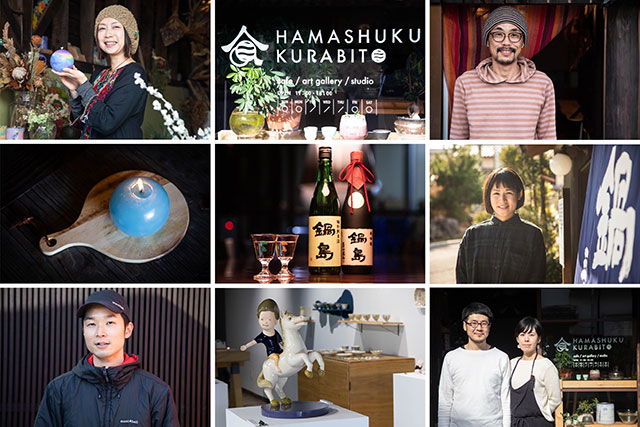

 Go here
Go here




